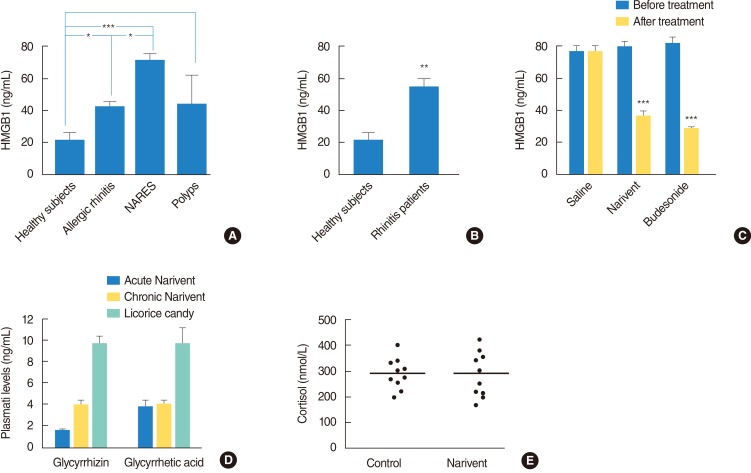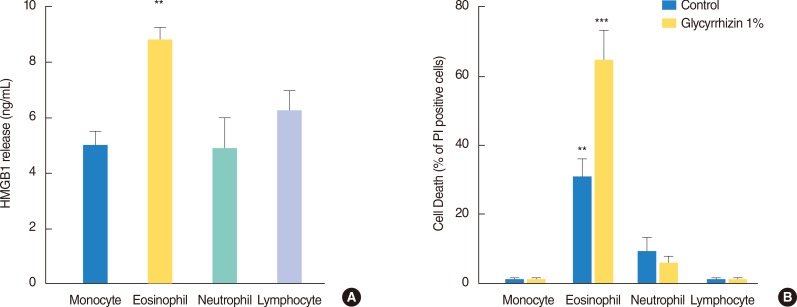1. Pallier C, Scaffidi P, Chopineau-Proust S, Agresti A, Nordmann P, Bianchi ME, et al. Association of chromatin proteins high mobility group box (HMGB) 1 and HMGB2 with mitotic chromosomes. Mol Biol Cell. 2003; 8. 14(8):3414–3426. PMID:
12925773.

2. Ulloa L, Messmer D. High-mobility group box 1 (HMGB1) protein: friend and foe. Cytokine Growth Factor Rev. 2006; 6. 17(3):189–201. PMID:
16513409.

3. Yang H, Wang H, Czura CJ, Tracey KJ. HMGB1 as a cytokine and therapeutic target. J Endotoxin Res. 2002; 8(6):469–472. PMID:
12697092.

4. Rouhiainen A, Tumova S, Valmu L, Kalkkinen N, Rauvala H. Pivotal advance: analysis of proinflammatory activity of highly purified eukaryotic recombinant HMGB1 (amphoterin). J Leukoc Biol. 2007; 1. 81(1):49–58. PMID:
16980512.
5. Cavone L, Muzzi M, Mencucci R, Sparatore B, Pedrazzi M, Moroni F, et al. 18β-glycyrrhetic acid inhibits immune activation triggered by HMGB1, a pro-inflammatory protein found in the tear fluid during conjunctivitis and blepharitis. Ocul Immunol Inflamm. 2011; 6. 19(3):180–185. PMID:
21426233.

6. Dumitriu IE, Baruah P, Manfredi AA, Bianchi ME, Rovere-Querini P. HMGB1: guiding immunity from within. Trends Immunol. 2005; 7. 26(7):381–387. PMID:
15978523.

7. Bianchi ME, Manfredi AA. Immunology: dangers in and out. Science. 2009; 3. 323(5922):1683–1684. PMID:
19325105.
8. Lotze MT, Tracey KJ. High-mobility group box 1 protein (HMGB1): nuclear weapon in the immune arsenal. Nat Rev Immunol. 2005; 4. 5(4):331–342. PMID:
15803152.

9. Agnello D, Wang H, Yang H, Tracey KJ, Ghezzi P. HMGB-1, a DNA-binding protein with cytokine activity, induces brain TNF and IL-6 production, and mediates anorexia and taste aversion. Cytokine. 2002; 5. 18(4):231–236. PMID:
12126646.

10. Mollica L, De Marchis F, Spitaleri A, Dallacosta C, Pennacchini D, Zamai M, et al. Glycyrrhizin binds to high-mobility group box 1 protein and inhibits its cytokine activities. Chem Biol. 2007; 4. 14(4):431–441. PMID:
17462578.

11. Fulkerson PC, Rothenberg ME. Targeting eosinophils in allergy, inflammation and beyond. Nat Rev Drug Discov. 2013; 2. 12(2):117–129. PMID:
23334207.

12. Salpietro C, Cuppari C, Grasso L, Tosca MA, Miraglia Del Giudice M, La Rosa M, et al. Nasal high-mobility group box-1 protein in children with allergic rhinitis. Int Arch Allergy Immunol. 2013; 161(2):116–121. PMID:
23343652.

13. Pittelli M, Felici R, Pitozzi V, Giovannelli L, Bigagli E, Cialdai F, et al. Pharmacological effects of exogenous NAD on mitochondrial bioenergetics, DNA repair, and apoptosis. Mol Pharmacol. 2011; 12. 80(6):1136–1146. PMID:
21917911.

14. Lapucci A, Pittelli M, Rapizzi E, Felici R, Moroni F, Chiarugi A. Poly (ADP-ribose) polymerase-1 is a nuclear epigenetic regulator of mitochondrial DNA repair and transcription. Mol Pharmacol. 2011; 6. 79(6):932–940. PMID:
21441600.
15. Damiani V, Camaioni A, Viti C, Scire AS, Morpurgo G, Gregori D. A single-centre, before-after study of the short- and long-term efficacy of Narivent(®) in the treatment of nasal congestion. J Int Med Res. 2012; 40(5):1931–1941. PMID:
23206477.

16. Olukoga A, Donaldson D. Liquorice and its health implications. J R Soc Promot Health. 2000; 6. 120(2):83–89. PMID:
10944880.

17. Rosenberg HF, Dyer KD, Foster PS. Eosinophils: changing perspectives in health and disease. Nat Rev Immunol. 2013; 1. 13(1):9–22. PMID:
23154224.

18. Lotfi R, Herzog GI, DeMarco RA, Beer-Stolz D, Lee JJ, Rubartelli A, et al. Eosinophils oxidize damage-associated molecular pattern molecules derived from stressed cells. J Immunol. 2009; 10. 183(8):5023–5031. PMID:
19794066.







 PDF
PDF Citation
Citation Print
Print


 XML Download
XML Download